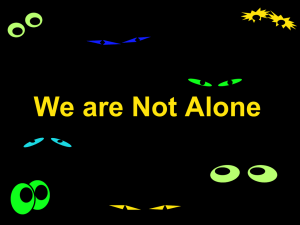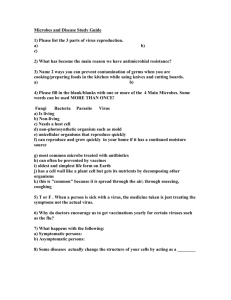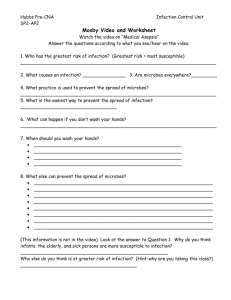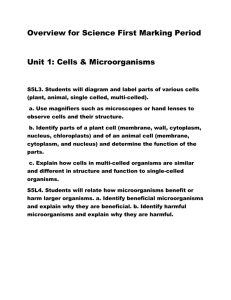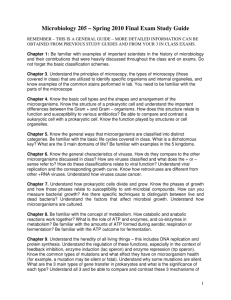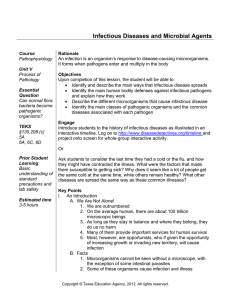We are Not Alone Ms. Potter's Principle of Health Science
advertisement
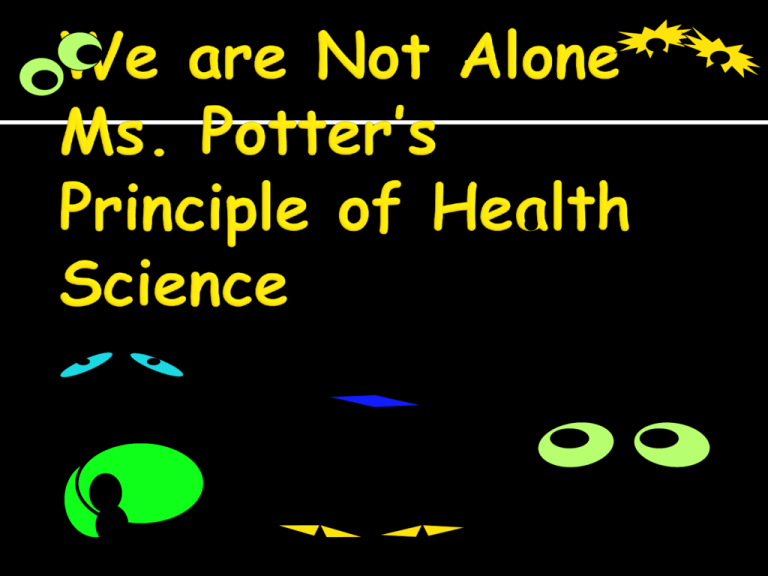
Introduction: They are in the air we breathe . . . In our food . . .On our skin . . . -on everything we touch. They are . . . microorganisms What are microorganisms? (also called microbes) Microbes are small living plants or animals most of which are not visible to the naked eye. Some microbes cause disease or infection. Many microbes are “good” organisms that help keep balance in the environment and the body. What microbes lack in size, they make up in number. On the average human, there are about 100 trillion microbes. Good vs. Bad Microorganisms: Microorganisms that cause disease (germs) are referred to as pathogens. Yeah, I’m bad. Microorganisms that are harmless or beneficial are called nonpathogens. Most microbes are considered beneficial or harmless. 87% beneficial organisms 10% Pathogens 3% opportunists The role of good microorganisms Marine & freshwater microbes form the basis of the food chain in oceans, lakes, and rivers. Soil microbes help break down wastes. Humans and other animals depend on bacteria in their intestines for digestion and synthesis of vitamins including: vitamin B (for metabolism) vitamin K (for blood clotting) Microorganisms have many commercial applications They are used in synthesis of chemical products such as: acetone organic acids alcohol enzymes many drugs They are used in the food industry for producing: pickles vinegar cheese alcoholic beverages green olives bread yogurt Aerobic organisms: Anaerobic organisms: Most microorganisms prefer warm, dark environments Main Classes of Pathogenic Organisms: 1) Bacteria • simple one-celled organisms • At home within “climate” of human body • compose largest group of pathogens 2)Fungi: yeasts & molds • Plant-like organisms that live on dead organic matter • Grow best in dark, damp places 3) Viruses - smallest microbes •acellular particles (not a complete cell) 4) Protozoa •one-celled animals often found in decayed materials & contaminated water 5) Helminths •parasitic worms •caused by larval & egg infestations Bacterial Infections Impetigo highly contagious bacterial infection Extensive case of impetigo on underarm of baby. Fetal Tetanus (note severe muscle contractions) Due to toxin production as a result of bacterial infection. Diphtheria Note swelling in neck Diphtheria membrane Cellulitis An acute bacterial inflammation of connective tissue. Lyme's Disease hallmark “bulls-eye” lesion Tiny deer tick vector that transmits lymes disease. Fungal Infections Candidiasis: Oral Thrush Oral Thrush: tongue Candidiasis of Skin Typical red, slightly most lesions. Nail Fungus Black Hairy Tongue Cutaneous Fungal Infection: Tinea Versicolor Note: hypopigmented fungal lesions Cutaneous Fungal Infection: Ringworm Cutaneous Blastomycosis: Hand & Wrist Subcutaneous Blastomycosis: Manifested by subcutaneous abscesses in upper chest Chromomycosis Deep fungal infection with granulomatous lesions. Viruses Viral Infection: Verruca Vulgaris (Wart) Herpes Type I: Oral Herpes More Oral Herpes healing stage Neonatal Herpes Premature infant born with classic “cigarette burn” pattern of HSV infection. Poliomyelitis (also called infantile paralysis) Note: deformed right leg Iron Lung: used by polio victims Varicella (Chickenpox with oral involvement) Measles (rubeola) Rash usually begins on face and spreads to trunk and extremities. Mumps: Note edema to cheeks and neck Viral Hepatitis Severely distended abdomen (ascites). Secondary complication from hepatitis. Parasitic & Protozoan Infections Leishmaniasis (protozoan systemic disease) Severe nodular, disfiguring lesions transmitted by sand fly Dracunculiasis (Fiery Dragon Worm) Found just under skin of human host. Causes blisters at site of infestation. Ulceration from worm. A fiery dragon worm emerges from leg. Elphantiasis (filariasis) Elphantiasis affecting left leg and genitals Intestinal helminthes cause infestations in intestinal tract and abdominal organs such as the liver and spleen. Always in pairs. Helminthes which have infested the liver. hepatomegaly and ascites Intestinal Roundworms Mass of 800 worms removed from child’s ileum during autopsy Loa Loa eye worm infestation in conjunctiva Loa loa being extracted from under conjunctivia. Hydatid cyst formed by tiny tapeworm that migrated to brain. That’s all folks. 1. Hepatitis B 2. Hepatitis C 3. AIDS virus that is spread through blood, serum and other body secretions. It affects the liver. virus that is spread through blood. It affects the liver and can lead to destruction of the liver and eventually death. There is a 3 series vaccination that can help protect for getting the virus. a virus that suppresses the immune system. People with AIDS cannot fight off infection that would not affect a healthy person. It is transmitted through blood and body secretions. It is very important as a health care worker to take every precaution against contracted these viruses. Good hand washing, always wear gloves and other protective equipment, and use caution when drawing blood or giving injections, are just a few safety precautions Summary •Microbes are microscopic organisms •About 100 trillion microbes live on the average human •“Bad” microbes are pathogens •About 3% of microorganisms are pathogenic •Main classes of pathogenic microbes include: bacteria, fungi, viruses, protoza, & helminths Causative agent: pathogen such as a bacteria or virus Reservoir: place for the causative agent (virus) to live. Such as the human body Fomites: objects that are contaminated with infectious material that contains pathogens (Examples: door knobs, bed pans, linens and specimen containers) means the infection or the disease originates within the body (Examples: tumors, metabolic disorders, and congenital abnormalities means the infection or disease originated from outside the body (Examples: radiation, chemical agents, trauma, and temperature extremes Infection that is acquired by an individual in a health care facility such as a hospital or nursing facility. These infections are usually passed to the patient by the health care worker (Examples: staph infection, and pseudomonas) Type of infection that occurs when the body’s defenses are weak. These diseases usually do not occur in healthy people (Examples: kaposi’s sarcoma, rare type of cancer or different types of pneumonia in people who have AIDS Antisepsis: Prevent or inhibit growth of pathogenic organisms but are not effective against spores and viruses. Examples: Alcohol and betadine Disinfection: process that destroys or kills pathogenic organisms. Not always effective against spores and viruses. Example: Chemical disinfectants Sterilization: process that destroys all microorganisms, both pathogenic and nonpathogenic, including spores and viruses. Autoclave: is the most common piece of equipment used for sterilization
